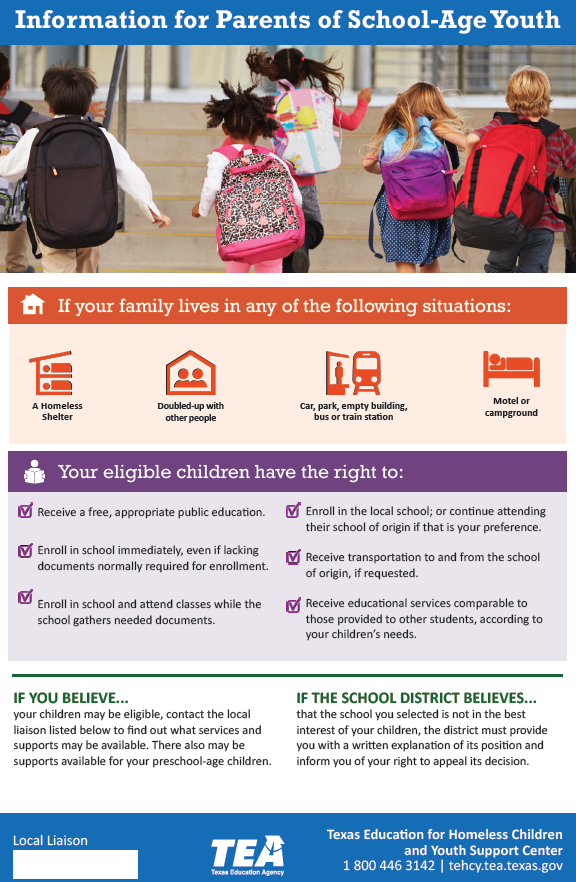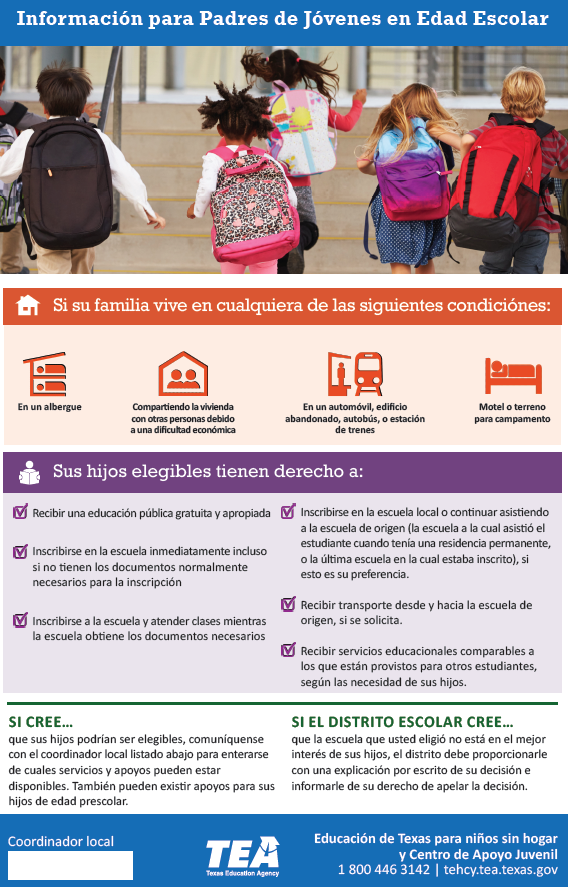Experiencing homelessness can have significant negative impacts on children academically, socially, and emotionally. The Education for Homeless Children and Youths (EHCY) program, authorized under the McKinney-Vento Homeless Assistance Act (McKinney-Vento Act), is designed to address the needs of homeless children and youths and ensure educational rights and protections for these children and youths. The Every Student Succeeds Act (ESSA) amended the McKinney-Vento Act, and changes made by the ESSA took effect on October 1, 2016.
Every school district should have a McKinney-Vento or Homeless representative. If you are having difficulty finding your representative, you can reach out to your education service center person to help you find your representative. You can also check the Homeless Liaison directory on the Texas Education for Homeless Children & Youth website.
Students who are experiencing homelessness are to be enrolled immediately. Districts cannot require students experiencing homelessness to provide proof of residency, immunizations, birth certificates guardianship documents, or any other sort of required paperwork before enrolling. Requiring missing paperwork or any other delay to enrollment is a violation of the McKinney-Vento Act.
Students who are experiencing homelessness have the right to attend school in their school of origin or in the school in the attendance area where the family or youth is currently residing.
Students experiencing homelessness have the right to transportation to their school of origin. This provision applies even if a student moves outside of the school of origins’ attendance zone or district boundaries. School of origin transportation must continue for the duration of the child’s homelessness or until the end of the school year in which a child becomes permanently housed.
A NEW school district (in consultation with the parents) must provide FAPE to the child (including services comparable to those described in the child’s IEP from the previous
district):
• The new school district adopts the child’s IEP from the previous district; OR
• The new school district develops, adopts, and implements a new IEP.
Who is Homeless?
The term “homeless children and youth”—
(A) means individuals who lack a fixed, regular, and adequate nighttime residence …; and
(B) includes—
(i) children and youths who are sharing the housing of other persons due to loss of housing, economic hardship, or a similar reason; are living in motels, hotels, trailer parks, or camping grounds due to the lack of alternative accommodations; are living in emergency or transitional shelters; are abandoned in hospitals;
(ii) children and youths who have a primary nighttime residence that is a public or private place not designed for or ordinarily used as a regular sleeping accommodation for
human beings;
(iii) children and youths who are living in cars, parks, public spaces, abandoned buildings, substandard housing, bus or train stations, or similar settings; and
(iv) migratory children who qualify as homeless for the purposes of this subtitle because the children are living in circumstances described in clauses (i) through (iii).
Homelessness & Truancy
A school district shall offer additional counseling to a student and may not refer the student to truancy court if the school determines that the student’s truancy is the result of:
(1) pregnancy;
(2) being in the state foster program;
(3) homelessness; or
(4) being the principal income earner for the student’s family.
Resources
Every Student Succeeds Act resources:
- OSEP Letter to States Special Education on Ensuring High Quality Education for Highly Mobile Children (Nov. 2022)
- Homeless Student Guidance (Updated August 2018)
- Letter regarding Title I, Part A reservation to serve homeless students (July 30, 2018)
- Homeless Student Guidance Fact Sheet (July 27, 2016)
- Homeless Student Notice of Rights and Protections (July 27, 2016)
Texas Education Agency – Texas Education For Homeless Children & Youth






